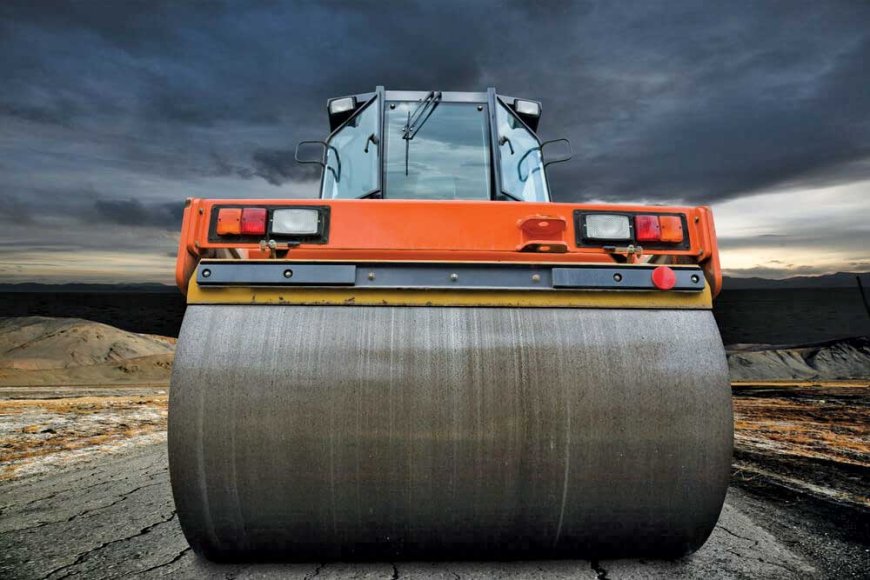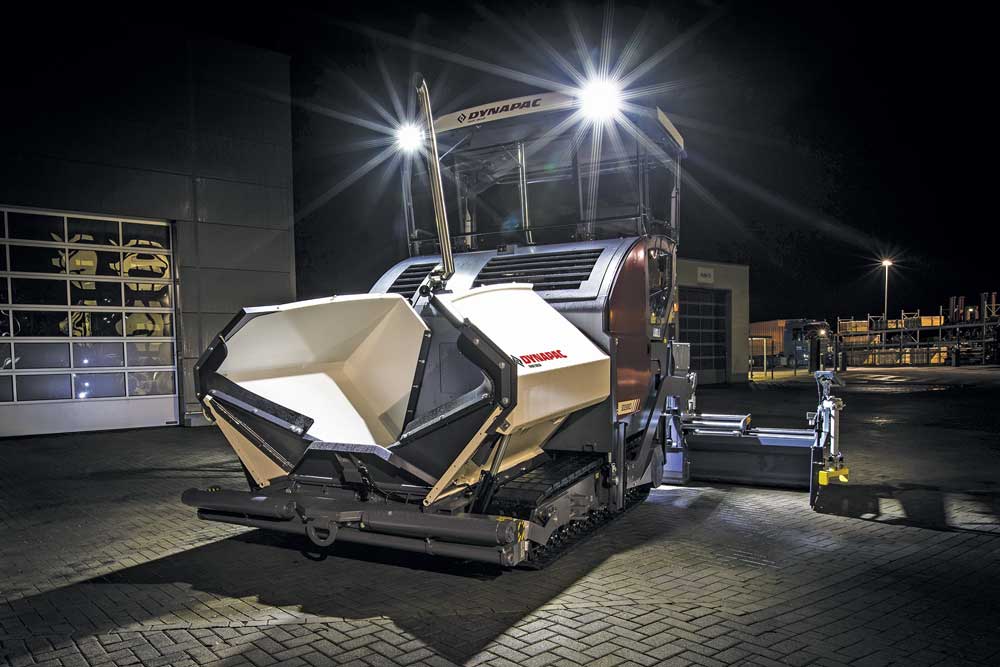Smooth & Steady!
Compaction equipment is a machine that removes soil from soil mass in order to obtain high soil density and water content. The primary application of compaction machinery is in the construction of water reservoir structures, roadways, and large commercial, residential,

Compaction equipment is a machine that removes soil from soil mass in order to obtain high soil density and water content. The primary application of compaction machinery is in the construction of water reservoir structures, roadways, and large commercial, residential, and industrial sites.
Equipment Times explores the current market scenario, growth potential, unique features, key maintenance practices, after-sales services, challenges and possible new avenues in the compaction equipment space.
Rapid urbanization, increased development of transportation infrastructure, destruction of old sites, and construction of new ones are major aspects projected to drive the global compaction equipment market. A considerable transition from a labor-centric strategy to mechanization is also projected to be a significant driving factor for the compaction equipment.
Furthermore, the trend of renting out compaction equipment is on the rise. This feature is expected to generate enormous growth opportunities for the compaction equipment market in the near future. Moreover, marketing of compaction equipment via numerous online channels is also expected to provide profitable prospects to the compaction equipment market in the coming years.
Growth in infrastructure and construction activities is the key factors driving the growth of the compactors market. The introduction of stringent regulatory policies is also fuelling the demand of this market. Whether it is asphalt compactors or soil compactors, the thrust from manufacturers has been on machines that will achieve optimum compaction with the minimum number of passes. Compactors come with few added advantages. The compactors market can be segmented based on product, type, application, and region. Based on product, the compactors market can be classified into landfill compactors, trash compactors, and others (wheeled, vibratory plate compactors, etc.). Based on type, the compactors market can be classified into stationary and portable. In terms of application, the compactors market can be segmented into municipal, industrial, agricultural, and others (construction, residential etc.).
Trends and Opportunities
The global compaction equipment market is expected to benefit from the booming construction sector across the globe. The increase in construction of smart cities and the rise in transportation construction are projected to drive the global compaction equipment market during the forecast period. Moreover, rising urbanization is expected to boost the demand for compaction equipment due to a huge number of deconstruction and new construction sites. The need for compaction equipment stems from the massive investments made by governments to improve infrastructure. Several ongoing and prospective road and dam projects are anticipated to drive the demand for compaction equipment during the forecast period.
Furthermore, the growing population, which would increase demand for residential constructions, is projected to support the compaction equipment market growth during the projection period. In the compaction equipment market, renting and leasing are expected to be popular options during the forecast period. Since compaction equipment is comparatively expensive, many customers prefer to rent or lease compaction equipment.
Better waste reduction through the compactor
According to constrofacilitator.com, waste is an unavoidable by-product of most human activity and compactors are used to dispose or to make it compact. Compactors are highly efficient since the amount of energy consumed by a compactor is low. In the current scenario, the major problem is the transportation of waste, which can be reduced by compacting or reducing the size of specific waste. A compactor can be used to reduce the volume of waste streams. The waste weight remains the same; hence, there will be no savings from the total amount of waste produced. However, savings will occur because the waste volume will be reduced. Economic development and rising living standards in the Asia Pacific region have led to an increase in the quantity and complexity of generated waste. Countries in this region need compactors to decrease the volume of waste. India and China, which are the top two populated countries, produce huge amounts of waste. A large amount of waste is processed by municipalities, for which compactors are used.
A move towards a quality vibratory system in compaction
Compaction is the single most important process in soil construction. Its job is to reduce the volume of pores in the soil to be compacted, which are filled with water and air. Compaction will give the soil the desired properties: Its resistance to stresses induced by traffic and climate will be improved by increasing its stability while simultaneously reducing its tendency to swell due to water absorption. The latter will additionally make the soil resistant to frost. Manufacturers are also focusing on coming out with machines that are fuel-efficient and require minimal maintenance, all adding to the good news for contractors. With competition, intensifying suppliers are concentrating on coming out with machines that would ideally suit Indian working conditions, where typically these machines would be put through more number of work cycles, as compared to the developed world. With articulated and pivot-steered tandem rollers of between 1.5 and 14 t, manufacturers are offering a large range of machines for practically any application in asphalt construction for all markets. This includes double vibration rollers, rollers with vibration and oscillation drums), combination rollers, vibration rollers with split drums and rollers with split vibration and oscillation drums.
A move towards high-performance compaction
Hydrostatic travel drive system enables the compactor to have smooth directional changes between forward and reverse, without scuffing the material surface. Hydraulic motors are mounted directly to the rear wheel assembly, driven by a variable displacement hydraulic pump. Hydraulic power steering provides precise steering to maximize surface coverage with uniform tire coverage. Maintenance-free hydrostatic drive enables a smooth transition between forward and reverses direction without damaging the mat. Isostatic leveling cylinders keep the front tyres in even contact with the material surface at all times. Irregularities in the material are removed and excellent surface sealing is achieved. Manufacturers are offering eight-wheeled pneumatic tyre rollers that offer the smoothest compaction yet designed for roadway applications. High-performance compaction aids you to finish your job on time and within budget.
Productive compactors for a better volume of work
Designed for productivity, manufacturers are providing a roller compactor range suitable for various projects, depending upon the volume of compaction work. Whether it’s a single drum soil compactor or a vibratory tandem road roller, every Compactor offers an efficiency which is more than what you expect. The single drum road roller models Besides, the machine is equipped with LiveLink and Compaction Coach – a Compaction Monitoring System that has been introduced to strengthen the roadways industry. It optimizes the number of passes and enables you to monitor the operator’s performance with real-time compaction alerts.
Importance to the operator’s flexibility of compactors
Compactors are now specially designed with operator comfort in mind. With its closed HVAC cabin and a more powerful engine, the compactor is highly suitable for heavier application usage. It is a product that will cater to activities as diverse as urban construction, road building, infrastructure, and mining. The soil compactor is also featuring a turbocharged after cooled engine with an internal Exhaust Gas Recirculation system for ensuring the best-in-class fuel economy. Additionally, the optimized HVAC Cabin gives an excellent front and rear drum/nozzle visibility, making the drive and compaction process easier and safer.
Intelligent compaction oscillation system
With oscillation, two unbalanced shafts rotate synchronously. The unbalances are offset by 180°. This causes the drum to carry out a rapidly alternating forward-backward rotary movement, with the result that the compaction energy is directed into the soil tangentially to the front and rear in the form of shear forces. In contrast to a vibrating drum, it acts dynamically on the soil all the time. Because the drum is always in contact with the ground, there is also a constant static load due to the weight of the machine. Manufacturers are using this technology of oscillation drums for tandem rollers and compactors. This means that intelligent compaction technology can be employed in both asphalt construction and earthwork.
Attention to operator safety of compactors
An operator’s efficiency is paramount about optimizing the output. Comfort and safety of an operator are of paramount importance as it not only ensures safe operations at the construction site but also increases the efficiency of the operator, reports constrofacilitator.com.
Manufacturers took special cognizance of this requirement and invested heavily in designing machines that offer the best-in-class safe operator environment. The in-built Compaction Meter is now being placed ergonomically for operator comfort thereby, helping in achieving the desired output, The steering wheel and console are designed to ensure fatigue-free operation and The cab platform is mounted on viscous mounts, to isolate it from any vibrations and to make the operator feel comfortable even during high amplitude passes. Moreover, compactors are now provided with isolated operator platforms, there is no feeling of vibration of the machine. This improves the stress-free operation of the machine & improves the operator’s efficiency. Hamm soil compactors are built with the patented design of three-point pendulum articulated joints. The three-point articulation joint connects the front & rear ends of the compactor & enables excellent directional stability and steerability & provides driver safety on difficult terrains and for the driver’s comfort.
Market leaders react…
 Ramesh Palagiri, Managing Director & CEO, Wirtgen India, said, “Growth in infrastructure and construction activities are the key factors driving the growth of the compactor market. The introduction of stringent regulatory policies is also fueling the demand of this market. Whether it is asphalt compactors or soil compactors, the thrust from manufacturers has been on machines that achieves optimum compaction with the minimum number of passes. Manufacturers are focusing on coming out with machines that are fuel-efficient and require minimal maintenance. With intensifying competition suppliers are concentrating on producing machines that would ideally suit Indian working conditions. With articulated and pivot-steered tandem rollers of between 1.5 and 14 t, manufacturers offer a large range of machines- for practically any application in asphalt construction for all markets. This includes double vibration rollers, rollers with vibration and oscillation drums, combination rollers, vibration rollers with split drums and rollers with split vibration and oscillation drums.”
Ramesh Palagiri, Managing Director & CEO, Wirtgen India, said, “Growth in infrastructure and construction activities are the key factors driving the growth of the compactor market. The introduction of stringent regulatory policies is also fueling the demand of this market. Whether it is asphalt compactors or soil compactors, the thrust from manufacturers has been on machines that achieves optimum compaction with the minimum number of passes. Manufacturers are focusing on coming out with machines that are fuel-efficient and require minimal maintenance. With intensifying competition suppliers are concentrating on producing machines that would ideally suit Indian working conditions. With articulated and pivot-steered tandem rollers of between 1.5 and 14 t, manufacturers offer a large range of machines- for practically any application in asphalt construction for all markets. This includes double vibration rollers, rollers with vibration and oscillation drums, combination rollers, vibration rollers with split drums and rollers with split vibration and oscillation drums.”
 Vishwesh Rai, National Sales Manager, Dynapac India, says, “At the current scenario, it is the demand of time that we need innovations for speedy and quality road construction. Dynapac has inherited culture of continuous improvement and innovation for superior performance and reliability. Our equipment is designed to perform and built to last in terms of low cost of ownership, quality results, high productivity, jobsite confidence and excellent serviceability. In compactors, we have optimized eccentricity for better fuel efficiency and economy. Dynapac was the first to introduce the efficient eccentrics system to the market in 2016. Dynapac equipment is equipped with high degree of intelligent compaction system.”
Vishwesh Rai, National Sales Manager, Dynapac India, says, “At the current scenario, it is the demand of time that we need innovations for speedy and quality road construction. Dynapac has inherited culture of continuous improvement and innovation for superior performance and reliability. Our equipment is designed to perform and built to last in terms of low cost of ownership, quality results, high productivity, jobsite confidence and excellent serviceability. In compactors, we have optimized eccentricity for better fuel efficiency and economy. Dynapac was the first to introduce the efficient eccentrics system to the market in 2016. Dynapac equipment is equipped with high degree of intelligent compaction system.”
 Jaikumar Kamath, L&T Construction and Mining Machinery. , said, “We are proud to say that the L&T range of Compactors are an example of ‘Made in India’ effort – 100% designed in-house, with 95% indigenous content and a step towards fulfilling the ‘Atmanibhar Bharat’ mission. Our design team continuously incorporates user feedback to improve performance. The Soil Compactor L&T 1190 has been optimized to give the most optimal fuel consumption. The Soil Compactor at 30mm thick drum is the heaviest in its range, ensuring better compaction. The service access to all the refill points is from the ground level. The Tandem Compactor L&T 990 HF-I with high frequency of 55 Htz helps in a smoother road finish. This is an improved variant introduced after incorporating customer feedback. The machine has a unique suspended frame design and allows compaction very close to the kerb. The Tandem Compactor has a rotatable operator console, which helps the operator get a very clear view of the drum edges. The engine compartment is housed in a separate compartment, which makes it very easy to access. Both the drum surfaces are visible from the operator seat in the L&T 990 HF-I Tandem Compactor.”
Jaikumar Kamath, L&T Construction and Mining Machinery. , said, “We are proud to say that the L&T range of Compactors are an example of ‘Made in India’ effort – 100% designed in-house, with 95% indigenous content and a step towards fulfilling the ‘Atmanibhar Bharat’ mission. Our design team continuously incorporates user feedback to improve performance. The Soil Compactor L&T 1190 has been optimized to give the most optimal fuel consumption. The Soil Compactor at 30mm thick drum is the heaviest in its range, ensuring better compaction. The service access to all the refill points is from the ground level. The Tandem Compactor L&T 990 HF-I with high frequency of 55 Htz helps in a smoother road finish. This is an improved variant introduced after incorporating customer feedback. The machine has a unique suspended frame design and allows compaction very close to the kerb. The Tandem Compactor has a rotatable operator console, which helps the operator get a very clear view of the drum edges. The engine compartment is housed in a separate compartment, which makes it very easy to access. Both the drum surfaces are visible from the operator seat in the L&T 990 HF-I Tandem Compactor.”

Hits: 2








